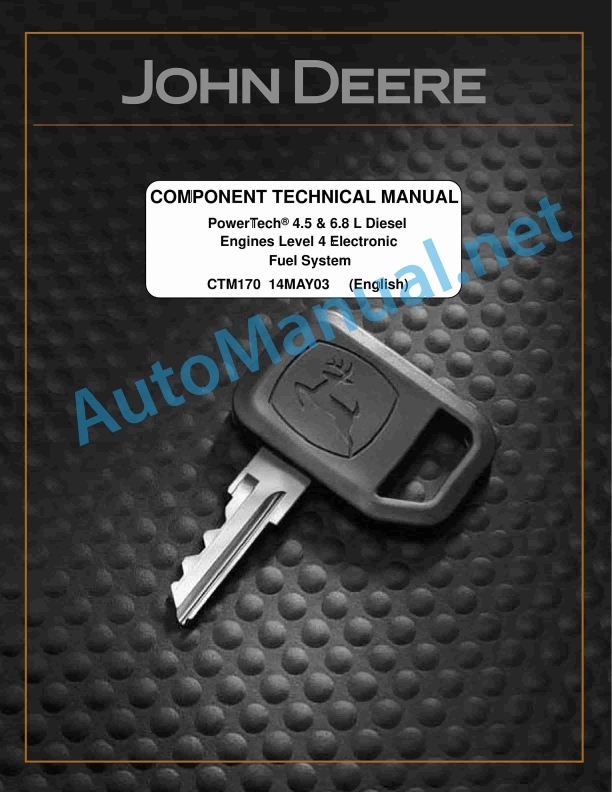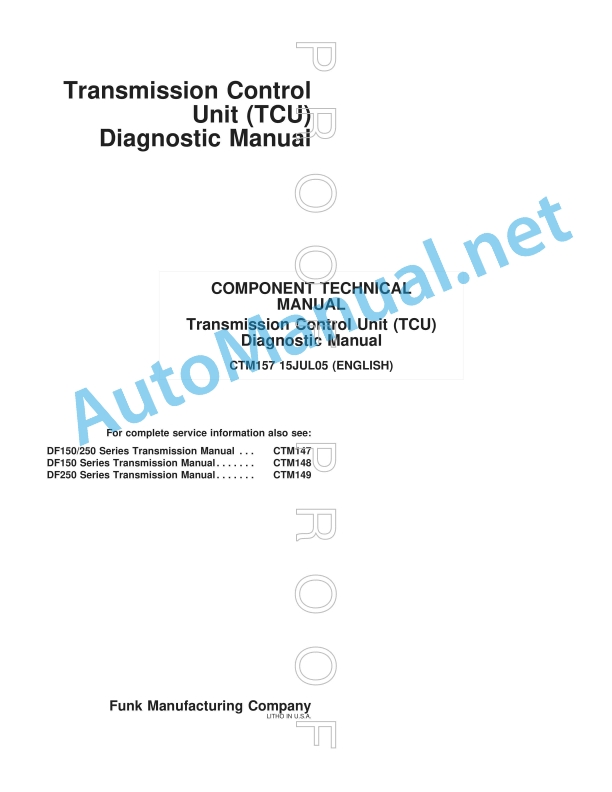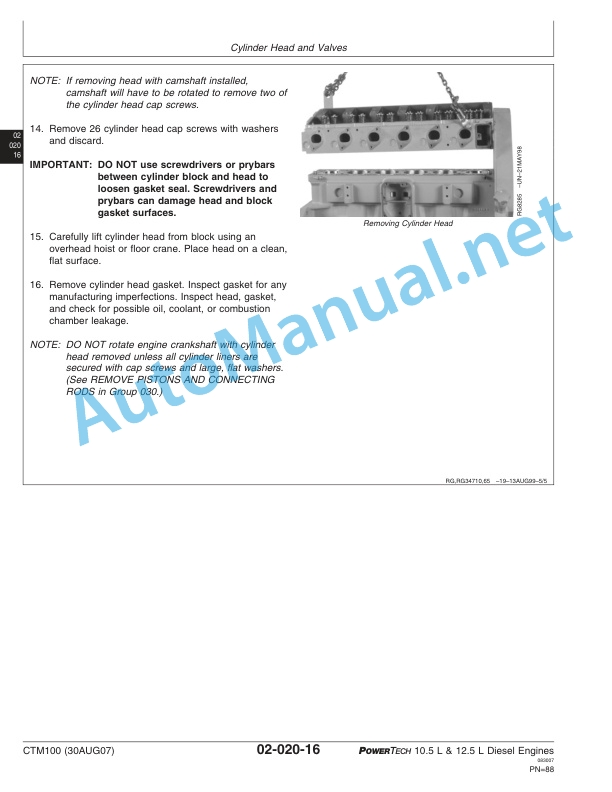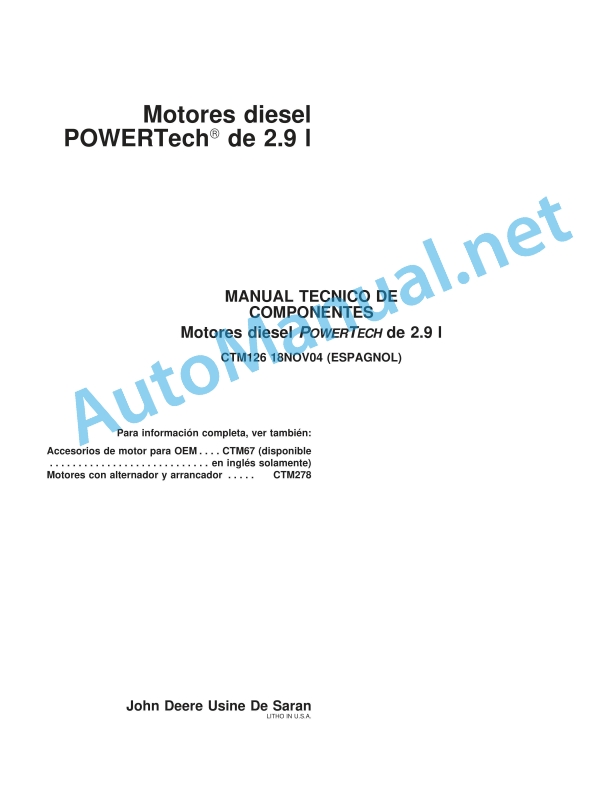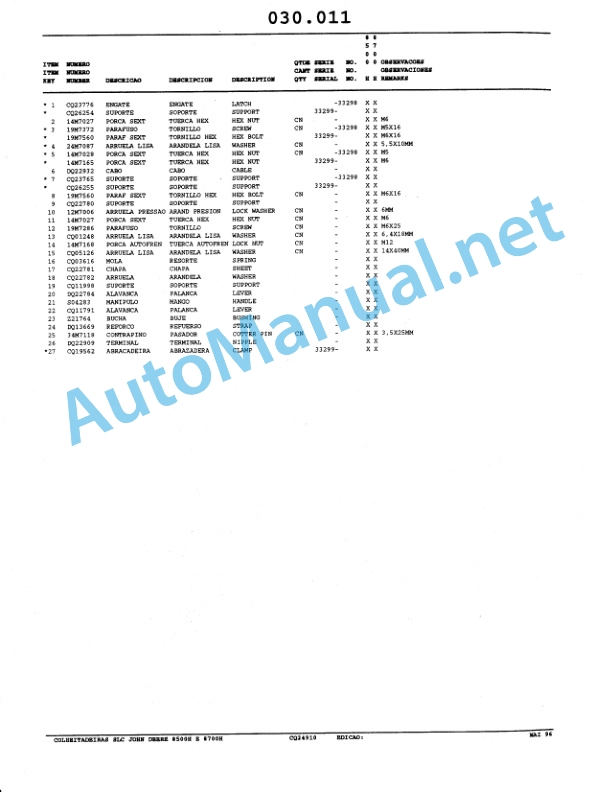Claas Nectis 237-217 Ve 2+4Wd (A12) Tractors Operator Manual ES
$50.00
- Model: Nectis 237-217 Ve 2+4Wd (A12) Tractors
- Type Of Manual: Operator Manual
- Language: ES
- Format: PDF(s)
- Size: 14.0 MB
File List:
00 1112 437 1.pdf
60 0503 104 8.pdf
00 1112 437 1.pdf:
For your security
Signal triangle
Use according to the purpose
Chapter symbols
A – IDENTIFICATION – APPROVAL – SECURITY
IDENTIFICATION A.2
Homologation A.2
SAFETY A.3
B – CABIN
Controls and driving position B.2
Right side controls B.3
Left side controls B.3
CONTROLS AND INSTRUMENTS (dashboard) B.4
Indicator and control lights B.5
ALARMS B.6
DIGITAL VIEWERS B.8
DRIVER SEAT B.9
Controls and accessories on the cabin roof B.10
Various controls and accessories B.10
Recommendation B.15
DRIVER SEAT B.17
Folding bow B.18
C – Electricity (cabin)
CHARACTERISTICS C.2
Lighting – signaling C.3
CONTROLS C.4
C.6 Fuses
C – Electricity (arc)
Lighting – signaling C.12
D – ENGINE
CHARACTERISTICS D.2
Operations to be carried out before starting D.3
ENGINE STARTING D.4
ENGINE STOPPING D.4
Bleeding the air from the injection circuit D.8
E – Transmission
NECTIS 227-237 VE, 227-237-247 VL, 227-247 F E.2
GEARBOX – 12/12 (30 km/h) E.2
NECTIS 257-267 VL, 257-267 F E.3
GEARBOX – 12/12 (30 km/h) E.3
NECTIS 227-237 VE, 227-237-247 VL, 227-247 F E.4
Gearbox with mechanical doubler – 24/24 (30 km/h) E.4
NECTIS 227-237 VE, 227-237-247 VL, 227-247 F E.5
Gearbox with mechanical doubler – 24/24 (40 km/h) E.5
NECTIS 257-267 Vl, 257-267 F E.6
Gearbox with mechanical doubler – 24/24 (40 km/h) E.6
NECTIS 227-237 Ve, 227-237-247 VL, 227-247 F E.7
Gearbox with twinshift and reverse shift – 24/12 (30 km/h) E.7
NECTIS 227-237 Ve, 227-237-247 VL, 227-247 F E.8
Gearbox with twinshift and reverse shift – 24/12 (40 km/h) E.8
NECTIS 257-267 Vl, 257-267 F E.9
Gearbox with twinshift and reverse shift – 24/12 (40 km/h) E.9
E.10 clutch
E.11 gearbox
Selection of the E.13 ranges
Differential E.13
Braking E.14
PTO E.15
Tractor trailer E.18
F – Front axle – front axle
Features F.2
Front axle gear F.5
G – Hydraulic system – rear lift and hitch
G.2 Features
G.3 rear lift
Elevation (Electronic Tract-Control) TCE 6 G.6
G.12 automatic couplers
G.13 rear hitch adjustment instructions
J – WHEELS AND TIRES
Generalities J.2
Inflation pressure J.2
Tires and tracks J.4
Front track start J.12
SWIVEL STOPERS J.13
Putting on rear track J.14
K – Dimensions, weights, capacities and ballast
K.2 cabin version dimensions
Bow version dimensions K.3
Weight K.4
Ballast K.6
K.7 Capabilities
L – Maintenance
Generalities L.2
M – Mandatory guarantee operations
MANDATORY OPERATIONS CARRIED OUT WITHIN THE FRAMEWORK OF THE CONTRACTUAL WARRANTY M.2
A – IDENTIFICATION – APPROVAL – SECURITY
Homologation
SECURITY
PRECAUTIONS TO BE TAKEN BEFORE CARRYING OUT START-UP
TRACTOR CONDITION
ADJUSTMENT OR MAINTENANCE WORK – REPAIRS
PLACING ON SUPPORTS
HYDRAULICS
ELECTRICITY
Cooling liquid
CIRCULATION – TRANSPORTATION
UTILIZATION
GENERAL RULE
TRACTOR WHEEL BASE
TOOL HOOKING
JOBS IN FIXED POSITION
WORK WITH TOOLS POWERED BY THE POWER TAKE-OFF
TOXIC PRODUCTS
Refrigeration
RECOMMENDATIONS:
SECURITY STRUCTURE
REGARDING THE ENVIRONMENT
Safety stickers with warning pictograms
D – ENGINE
CHARACTERISTICS
Operations to be carried out before starting
ENGINE STARTING
ENGINE STOP
UTILIZATION
Generalities
Recommendations:
1 – Avoid working under load or long idling operations. A lack of charging in the first 100 hours can cause the liners to glaze. The consequence is excessively high oil consumption and a lack of power.
2 – Avoid overload work: there is overload when a gearbox ratio that is too high is used and when the engine speed drops between 1,600 and 1,800 rpm, even if the accelerator is at maximum. A use of…
3 – In particular, monitor the levels (oil and coolant) as well as the engine temperature.
Use temperature
REGIME OF USE
Slow motion
Maximum vacuum regime
Specific consumption
Work with partial potential
Work at full power
Generalities
Quality requirement
Tank filling
1 – Clean the area around the diesel cap.
2 – Remove the cap (1) and put it in a clean and dry place
3 – After filling, replace the cap and tighten it.
Fuel handling
Bleeding air from the injection circuit
E – Transmission
NECTIS 227-237 VE, 227-237-247 VL, 227-247 F
GEARBOX – 12/12 (30 km/h)
NECTIS 257-267 VL, 257-267 F
GEARBOX – 12/12 (30 km/h)
NECTIS 227-237 VE, 227-237-247 VL, 227-247 F
Gearbox with mechanical doubler – 24/24 (30 km/h)
NECTIS 227-237 VE, 227-237-247 VL, 227-247 F
Gearbox with mechanical doubler – 24/24 (40 km/h)
NECTIS 257-267 Vl, 257-267 F
Gearbox with mechanical doubler – 24/24 (40 km/h)
NECTIS 227-237 Ve, 227-237-247 VL, 227-247 F
Gearbox with twinshift and reverse shift – 24/12 (30 km/h)
The speed in reverse gear is between the tortoise and hare values of forward gear.
NECTIS 227-237 Ve, 227-237-247 VL, 227-247 F
Gearbox with twinshift and reverse shift – 24/12 (40 km/h)
The speed in reverse gear is between the tortoise and hare values of forward gear.
NECTIS 257-267 Vl, 257-267 F
Gearbox with twinshift and reverse shift – 24/12 (40 km/h)
The speed in reverse gear is between the tortoise and har ward gear.
Forward speed tables
contactor
mechanical gear reverser
I March forward.
II Reverse gear.
Electrohydraulic reverse gear (reverser under load)
I Forward march
II Neutral point
III reverse gear
IV Disengaged
Speed selection
Mechanical range bender
Electrohydraulic range bender
Range selection
I Reduced gear
II Slow march
III Normal gait
N Neutral
Differential
Brake pedal (1)
trailer brake
Hydraulic braking
Handbrake (3)
To tighten:
To untighten:
power take off
mechanical interlock power take off
Disengagement
Hydraulic Interlock PTO
Selection of standard or proportional power take-off regimes
Selection of power take-off regimes
PTO tool hitch and trai Importa Permanent job
tractor trailer
F – Front axle – front axle
Characteristics
Synchronism ratio
Front axle gear
Version with electrohydraulic control
Operating mode
Selection of operating mode
Forced mode
Automatic mode
Version with mechanical control (lever)
G – Hydraulic system – rear lift and hitch
Characteristics
Hydraulic pump
Simple pump circuit
Double pump circuit
Triple pump circuit
Oil capacities
Refer to chapter K.
Hydraulic lifting
Lifting with effort and position control.
rear hitch
VL and F models
Model VE
rear lift
Position control
Utilization
Effort control
Utilization
Adjustment
Tool maneuver at the end of the field
Position control
Effort control
Tool maneuver in effort control
Mixed control
Utilization
Adjustment
Tool maneuver at the end of the field
Swing hitch
Tool maneuver at the end of the field
Adjustment valve (A)
Adjustment valve (B)
Sensitivity
1 – Bottom hole: Maximum sensitivity.
2 – Central hole: Medium sensitivity.
3 – Upper hole: Minimum sensitivity.
PARTICULAR CASES
Elevation (Track-Electronic Control) TCE 6
Control desk
1 – Stop position indicator light.
2 – Lift movement indicator light (up).
3 – Lifting (lowering) movement indicator light.
4 – Control mode adjustment knob (effort / position).
5 – High stop adjustment knob.
6 – Setpoint adjustment knob (mixed position or effort).
7 – Descent speed adjustment wheel.
8 – Transport lock button.
9 – 3-position memory button.
10 – Quick grounding key.
Lift start-up
Position control
UTILIZATION
Effort control
High stop adjustment
UTILIZATION
Descent speed adjustment
Quick ground function
Exterior control button functions
Memory button 3 positions
high position
Stop position
Job position
Locking function in transport mode
Movement indicator light
Safety and lifting alarm indicator
Regular intermittent ignition
Slow/fast intermittent ignition
Automatic hitches
Automatic hooks
Tool attachment
Tool release
Maintenance
Rear hitch adjustment instructions
Influence of hitch geometry on lifting capacity
A – Upper bar (attachment point of the upper connecting rod with respect to the wheel axis and length of the connecting rod). In all cases it is necessary to take into consideration that the different attachment positions of the connecting rod in the three or…
B – Lower bars (attachment points for the lifting rods on the lower bars, according to the different versions).
C – Lifting rods (length of the lifting rods).
Maximum mechanical advantage
Minimum mechanical advantage
Lifting Rod Adjustment
Upper crank adjustment
Adjustment
Adjusting the lateral stabilizers
Mechanical adjustment of the lateral stabilizers
Hydraulic adjustment of lateral stabilizers
Hydraulic adjustment of stabilizers with lateral deviation
1 – With the button (C) in position (A) the lever (D) allows the following adjustments:
2 – With the button (C) in position (B) the lever (D) allows the following adjustments:
Hydraulic vertical tie rod
Trailer hitch
Height-adjustable sliding hitch fork
Height-adjustable hitch fork (fixation by pins)
Swing hitch bar (E)
Auxiliary distributors
Control levers and pressure taps
Auxiliary distributor combinations
Simple pump circuit
Double pump circuit
Triple pump circuit
Simple pump circuit
Double pump circuit
Triple pump circuit
Flow regulator adjustment
Double acting/single acting conversion
Free return
J – WHEELS AND TIRES
Generalities
REPLACING TIRES, INSTALLING TRAINS OF DIFFERENT TIRES
Particular case of four-wheel drive tractors
Synchronism ratio
inflation pressure
Work on soft ground (search for better grip)
Work on hard ground (on the road, trailer, etc.)
Tires and tracks
The front track is the distance on the ground that separates the center of the front tires. The rear track is the distance on the ground that separates the center of the rear tires.
Tire combinations
Nectis VE
Nectis VL
Nectis F
Front Track Tables (2 Wheel Drive) Nectis VE, VL & F
Front Track Tables (4 Wheel Drive)
Nectis VE & VL (with narrow front bridge)
Nectis 227 VL – 237 VL – 247 VL
Front Track Tables (4 Wheel Drive)
Nectis 257-267 VL
Nectis 227-247 F
Front Track Tables (4 Wheel Drive)
Nectis 247-257-267 F
Rear track boards
Nectis VE
Nectis VL
Rear track boards
Nectis F
Front track start
Front axle (2-wheel drive)
Engine front axle
SWIVEL STOPERS
Adjustment
Putting on rear track
K – Dimensions, weights, capacities and ballast
Cabin version dimensions
Arch version dimensions
Total authorized loaded weight
Ballasted
At the chain exit, the tractors are ballasted in order to behave normally in most cases of use.
Capabilities
The following table indicates the quantities of lubricant and fluid to be used for each organ.
Only use recommended lubricants and fluids.
When refilling, it is mandatory not to change the oil or fluid category.
Regular oil changes are essential.
L – Maintenance
Generalities
Warnings
General cleaning
High pressure cleaning system
Current interventions
Paint touch ups
FAULTS OR MALFUNCTIONS
Downgrade
Amount and type of oil
Fat quality
Cabin air filter: Cleaning
Window washer fluid level: Check
Diesel artichoke: Change
Mechanical forward clutch clearance: Check
Engine oil level: Check
Elimination of water present in fuel: Cleaning
Coolant level: Check
Service brake fluid level: Check
Hydraulic oil level: Check
Important: – The oil level must never be below the lower indication (III). – In case of using hydraulic tools that take a large amount of oil in the transmission (hydraulic motors, high capacity jacks…
Transmission oil cooler: Cleaning
Air conditioning compressor: Compressor lubrication
Calender grilles: Cleaning
Positioning the front axle arm (4-wheel drive): Greasing
Rear Lift: Greasing
Front axle final reduction oil level: Check
Front axle differential case oil level: Check
Front axle wheel pivots: Greasing
Front axle steering jack: Grease
Clean the grease nipples (C) and lubricate.
Wheel disc and rim nut tightening: Control
Tire inflation pressure: Check
Tightening of the front masses: Check
Cabin air filter: Replacement
Battery terminals: Cleaning – greasing
Engine oil: Change
Engine oil filter cartridge: Change
Diesel filter cartridges
3 cylinder models
4 cylinder models
Alternator belt and engine water pump
Compressor belt: Control
Third hydraulic pump belt: Control
Front axle steering pivots: Greasing
Front axle balance pivot: Greasing
Front axle final reduction oil: Change
Hydraulic circuit filter cartridges – transmission:
High pressure filter replacement
Electrohydraulic inverter filter
Circuit air purge
Mechanical PTO clutch control: Control
Service brake guard: Control
Hydraulic circuit accumulator (version with torque inverter): Control
Safety patch solenoid valve (version with torque inverter): Control
Front axle differential case oil: Change
Hydraulic oil – transmission: Gear
Hydraulic shower head: Change
Handbrake Guard: Control
Front axle breather: Change
Engine air filter: Change
Brake circuit fluid: Change
Diesel artichoke: Change
Engine maintenance
Hydraulic circuit accumulator
Air conditioning dehydrator: Change
ONBOARD NOTEBOOK OF MAINTENANCE OPERATIONS
Operations to be carried out every 500 hours
Operations to be carried out every 1,000 hours
Operations to be carried out every 2,000 hours
M – Mandatory guarantee operations
MANDATORY OPERATIONS CARRIED OUT WITHIN THE FRAMEWORK OF THE CONTRACTUAL WARRANTY
Inspection before delivery – Delivery to customer
a) Inspection before delivery
Your supplier, holder of the CLAAS label, is responsible for preparing your tractor before delivery:
You must put your seal and signature after having checked and validated the maintenance card controls.
At your request, you can also install approved equipment or any After-Sales option (cooling, power take-off and front lift, radio, etc.).
b) Delivery to customer
When delivering the tractor, your supplier must also give you the use and maintenance guide. You must discuss this document with you and carry out a field test with you, in order to familiarize you with your new tractor and answer all…
The Acknowledgment of receipt, Inspection before delivery and Delivery to customer forms (present in the maintenance card) must be completed and signed by the technician in charge of carrying out the practices, as well as by the user.
One of the copies of the acknowledgment of receipt will remain in the maintenance card given to the user. The other copies are destined for CLAAS.
MAINTENANCE OPERATIONS TO BE CARRIED OUT
HYDRAULIC CIRCUIT
HYDROSTATIC STEERING
FRONT UNIT – FRONT BRIDGE
TRANSMISSION – LIFT
WHEELS AND TIRES
ELECTRICAL CIRCUIT
Battery:
Dashboard:
Lighting:
Heating, ventilation, cooling:
HYDRAULIC CIRCUIT
HYDROSTATIC STEERING
FRONT UNIT – FRONT BRIDGE
TRANSMISSION – LIFT
WHEELS AND TIRES
ELECTRICAL CIRCUIT
Battery:
Dashboard:
Lighting:
Heating, ventilation, cooling.
B_ES.pdf
B – CABIN
Controls and driving position
Assembly A: Assembly with electrohydraulic bender and inverter under load.
Montage B: Assembly with mechanical bender and mechanical reverse gear.
1 – PTO clutch lever (hydraulic clutch version).
2 – Clutch pedal.
3 – Standard or proportional power take-off claw clutch lever.
4 – Electrohydraulic reverse gear lever.
5 – Height-adjustable steering wheel.
6 – Dashboard.
7 – Multifunction control lever (turn signals, lights and horn).
8 – General key contactor.
9 – Brake pedals.
10 – Gear lever and hydraulic bending control.
11 – Accelerator pedal.
12 – Driver’s seat.
13 – Range lever.
14 – Auxiliary distributor control lever.
15 – Mechanical gear shift lever.
16 – Mechanical bender control lever.
17 – Gear lever.
Right side controls
Montage A: Mounting with electronic elevation. Montage B: Assembly with mechanical lifting.
1 – 2nd auxiliary distributor control lever.
2 – Hand throttle lever.
3 – Electronic lifting box.
4 – Hydraulic lifting arm control lever.
5 – Distributor control lever to control traction tie rod.
6 – Deflection or central position selection button for the traction tie rods.
7 – Position control lever.
8 – Effort control lever.
Left side controls
1 – PTO clutch lever (mechanical clutch version)*.
2 – 4-wheel drive claw clutch lever (mechanical clutch version)*.
CONTROLS AND INSTRUMENTS (dashboard)
1 – Free position.
2 – Rotating headlight control button (arc).
3 – Emergency signal button.
4 – Dashboard.
5 – Free position.
6 – Front axle locking button.
7 – Differential lock control button.
8 – On-board computer button.
9 – Multifunction control lever (turn signals, lights and horn).
10 – General key contactor.
Indicator and control lights
1 – Fuel reserve warning light.
2 – Road projector warning light.
3 – 2nd trailer turn signal light.
4 – 1st trailer turn signal light.
5 – Tractor turn signal light.
6 – Rear power take-off warning light.
7 – Front power take-off warning light.
8 – Brake fluid level indicator.
9 – Handbrake warning light.
10 – Battery charge indicator.
11 – Emergency stop warning light.
12 – Engine oil pressure warning light.
13 – Hydraulic bender oil pressure warning light.
14 – Transmission oil temperature warning light.
15 – Dry air filter clogged warning light
16 – Preheating indicator (option).
17 – Not used.
18 – Transmission computer failure warning light.
19 – Hydraulic bender warning light (reduced speed).
20 – Front axle interlock warning light.
21 – Engine coolant temperature warning light.
22 – Differential lock warning light.
23 – Fuel decanter level indicator.
A – Fuel level indicator.
B – Engine speed indicator in r.m.
C – Engine coolant temperature indicator.
D – Theoretical forward speed indicator in km/h or mph.
E – Visualizer:
RED LIGHTS PRIMARY ALARMS
Emergency stop warning light
Battery charge indicator*
Engine oil pressure warning light*
Engine coolant temperature warning light*
1 – Clean the grill grates and radiators.
2 – Check that the water pump belt is neither loose nor broken.
3 – Check the cooling liquid level.
Hydraulic (bender) circuit oil pressure warning light*
Transmission oil temperature warning light*
Handbrake warning light*
ORANGE SECONDARY ALARMS WARNING LIGHTS
Preheating indicator (option)
Dry air filter clogging indicator
Fuel reserve warning light
Transmission computer failure warning light
DIGITAL VIEWERS
Digital indicator d
Digital display e
Resetting the partial hour counter
Setting the digital clock
DRIVER SEAT
Pneumatic seat (A)
1 – Vertical suspension (stiffness adjustment).
2 – Longitudinal positions.
Comfort seat (B)
3 – Longitudinal adjustment.
4 – Suspension adjustment.
5 – Adjustment according to weight.
Seat belts (C)
Controls and accessories on the cabin roof
RIGHT SIDE
1 – Rotating headlight contactor.
2 – Car radio location.
3 – Speaker.
4 – Front work lights contactor.
5 – Rear work lights contactor.
6 – Ceiling light.
7 – Front windshield wiper switch.
8 – Rear windshield wiper switch.
car radio
Pre-installation
Various controls and accessories
Natural aeration
Sliding rear glass (A)
Sliding windshield (A)
Adjustable steering column
Exterior mirrors
Adjustment
Adjustment
Interior mirror
Sunshade curtain
Functioning
Heating – ventilation – cooling
1 – Adjustment of the amount of air expelled.
2 – Start-up of the air conditioning.
3 – Air temperature adjustment.
Adjusting the amount of air expelled
Air temperature adjustment
Air-conditioning
Cable routing (1)
Recommendation
Cleaning
DRIVER SEAT
waterproof seat
1 – Longitudinal adjustment.
2 – Suspension adjustment.
3 – Adjustment according to weight.
Adjustment
folding bow
C_ES.pdf
C – Electricity (cabin)
Characteristics
Light bulbs
Power suppliers
Trailer/tool light socket (A)
1 – Turn signals on the left side.
2 – Available.
Turn signals on the right side.
5 – Right side headlights + license plate lighting.
6 – Stop.
7 – Left side headlights.
Electrical box power plug (B)
Lighting – signaling
IN THE FRONT
1 – High beam lights.
2 – Dipped headlights.
3 – Side indicators:
4 – Work lights.
In the back
5 – Rotating lighthouse.
6 – Side indicators:
7 – Plate illuminator.
8 – Work lights.
9 – Catalights.
Controls
Flashing
Sound warning (III)
Driving lights
Bursts of lights
rotating lighthouse
distress signal
work lights
Wiper washer
Glass cleaner
Ceiling light (D)
key contactor
Key switch position
Fuse assignment
flywheel fuse
1 – The steering wheel fuse (tractor section) is located near the alternator.
2 – The steering wheel fuse (cabin section) is located near the battery box.
3 – The starter relay is located near the alternator.
Fuse and electronic lift relay
Fuse box
In version with USC transmission, tractors can be equipped with fuse box (A) or fuse box (B).
Version with inverter transmission under load: Fuse box (A)
The fuse box (A) is located under the left dashboard panel.
The fuse box (B) is located under the left dashboard panel.
Fuse box (cabin)
Version with mechanical transmission
Fuse box
C – Electricity (arc)
Lighting – signaling
1 – Rotating lighthouse.
2 – Work lights.
3 – Side indicators:
Side indicators
work light
60 0503 104 8.pdf:
For your security
Signal triangle
Use according to the purpose
Chapter symbols
A – IDENTIFICATION – APPROVAL – SECURITY
IDENTIFICATION A.2
Homologation A.2
SAFETY A.3
B – CABIN
Controls and cockpit B.2
Right side controls B.3
Left side controls B.3
CONTROLS AND INSTRUMENTS (dashboard) B.4
Indicator and control lights B.5
ALARMS B.6
DIGITAL VIEWERS B.8
DRIVER SEAT B.9
Controls and accessories on the cabin roof B.10
Various controls and accessories B.10
Recommendation B.14
DRIVER SEAT B.16
Folding bow B.17
C – Electricity (cabin)
CHARACTERISTICS C.2
Lighting – signaling C.3
CONTROLS C.4
C.6 Fuses
C – Electricity (arc)
Lighting – signaling C.12
D – ENGINE
CHARACTERISTICS D.2
Operations to be carried out before starting D.3
ENGINE STARTING D.4
ENGINE STOPPING D.4
Bleeding the air from the injection circuit D.8
E – Transmission
Gearbox 30 km/h 12 + 12 slow speeds: VE – VL – F (3 cylinders) E.2
Gearbox 30 km/h 12 + 12 slow speeds: VL – F (4 cylinders) E.3
Gearbox 30 km/h 12 + 12 super slow speeds: VL – F (4 cylinders) E.3
Gearbox 30 km/h 24 + 24: VE – VL – F (3 cylinders, 2 driving wheels) mechanical doubler E.4
Gearbox 40 km/h 24 + 24: VE – VL – F (3 cylinders, 4 wheel drive) mechanical doubler E.5
Gearbox 30 km/h 24 + 24: VL – F (4 cylinders, 2 driving wheels) mechanical doubler E.6
Gearbox 40 km/h 24 + 24: VL – F (4 cylinders, 4 wheel drive) mechanical doubler E.7
Gearbox 30 km/h 24 + 12 inverter under load: VE – VL – F (3 cylinders) E.8
Gearbox 30 km/h 24 + 12 inverter under load: VL – F (4 cylinders) E.9
Gearbox 40 km/h 24 + 12 inverter under load: VE (3 cylinders) – VL and F (4 cylinders) (4 wheel drive) E.10
Gearbox 40 km/h 24 + 12 inverter under load: VL – F (4 cylinders, 4 wheel drive) E.11
E.12 clutch
E.13 gearbox
Selection of E.15 ranges
Differential E.15
Braking E.16
PTO E.17
Tractor trailer E.20
F – Front axle – front axle
Features F.2
Front axle gear F.3
G – Hydraulic system – rear lift and hitch
G.2 Features
G.3 rear lift
Elevation (Electronic Tract-Control) TCE 6 G.6
G.12 automatic couplers
G.13 rear hitch adjustment instructions
J – WHEELS AND TIRES
Generalities J.2
Inflation pressure J.2
Tires and tracks J.4
Front track start J.13
SWIVEL STOPERS J.14
Putting on rear track J.15
K – Dimensions, weights, capacities and ballast
K.2 cabin version dimensions
Bow version dimensions K.3
Weight K.4
Ballast K.5
K.6 Capabilities
L – Maintenance
Generalities L.2
M – Mandatory guarantee operations
MANDATORY OPERATIONS CARRIED OUT WITHIN THE FRAMEWORK OF THE CONTRACTUAL WARRANTY M.2
A – IDENTIFICATION – APPROVAL – SECURITY
Homologation
SECURITY
PRECAUTIONS TO BE TAKEN BEFORE CARRYING OUT START-UP
TRACTOR CONDITION
ADJUSTMENT OR MAINTENANCE WORK – REPAIRS
PLACING ON SUPPORTS
HYDRAULICS
ELECTRICITY
Cooling liquid
CIRCULATION – TRANSPORTATION
UTILIZATION
GENERAL RULE
TRACTOR WHEEL BASE
TOOL HOOKING
JOBS IN FIXED POSITION
WORK WITH TOOLS POWERED BY THE POWER TAKE-OFF
TOXIC PRODUCTS
Refrigeration
RECOMMENDATIONS:
SECURITY STRUCTURE
Safety stickers with warning pictograms
B – CABIN
Controls and cockpit
Assembly A: Assembly with electrohydraulic bender and inverter under load.
Montage B: Assembly with mechanical bender and mechanical reverse gear.
1 – PTO clutch lever (hydraulic clutch version).
2 – Clutch pedal.
3 – Standard or proportional power take-off claw clutch lever.
4 – Electrohydraulic reverse gear lever.
5 – Height-adjustable steering wheel.
6 – Dashboard.
7 – Multifunction control lever (turn signals, lights and horn).
8 – General key contactor.
9 – Brake pedals.
10 – Gear lever and hydraulic bending control.
11 – Accelerator pedal.
12 – Driver’s seat.
13 – Range lever.
14 – Auxiliary distributor control lever.
15 – Mechanical gear shift lever.
16 – Mechanical bender control lever.
17 – Gear lever.
Right side controls
Montage A: Mounting with electronic elevation. Montage B: Assembly with mechanical lifting.
1 – 2nd auxiliary distributor control lever.
2 – Hand throttle lever.
3 – Electronic lifting box.
4 – Hydraulic lifting arm control lever.
5 – Distributor control lever to control traction tie rod.
6 – Deflection or central position selection button for the traction tie rods.
7 – Position control lever.
8 – Effort control lever.
Left side controls
1 – PTO clutch lever (mechanical clutch version)*.
2 – 4-wheel drive claw clutch lever (mechanical clutch version)*.
CONTROLS AND INSTRUMENTS (dashboard)
1 – Free position.
2 – Rotating headlight control button (arc).
3 – Emergency signal button.
4 – Dashboard.
5 – Free position.
6 – Front axle locking button.
7 – Differential lock control button.
8 – On-board computer button.
9 – Multifunction control lever (turn signals, lights and horn).
10 – General key contactor.
Indicator and control lights
1 – Fuel reserve warning light.
2 – Road projector warning light.
3 – 2nd trailer turn signal light.
4 – 1st trailer turn signal light.
5 – Tractor turn signal light.
6 – Rear power take-off warning light.
7 – Front power take-off warning light.
8 – Brake fluid level indicator.
9 – Handbrake warning light.
10 – Battery charge indicator.
11 – Emergency stop warning light.
12 – Engine oil pressure warning light.
13 – Hydraulic bender o
John Deere Repair Technical Manual PDF
John Deere Repair Technical Manual PDF
John Deere Repair Technical Manual PDF
John Deere Repair Technical Manual PDF
John Deere Repair Technical Manual PDF
John Deere Transmission Control Unit Component Technical Manual CTM157 15JUL05
John Deere Repair Technical Manual PDF
John Deere Repair Technical Manual PDF
John Deere Repair Technical Manual PDF
John Deere Repair Technical Manual PDF
John Deere Diesel Engines POWERTECH 2.9 L Component Technical Manual CTM126 Spanish
John Deere Parts Catalog PDF
John Deere Harvesters 8500 and 8700 Parts Catalog CPCQ24910 Spanish








